Transform fallen leaves into valuable leaf mold for your garden this fall
Advertisement
Read this article for free:
or
Already have an account? Log in here »
To continue reading, please subscribe:
Monthly Digital Subscription
$0 for the first 4 weeks*
- Enjoy unlimited reading on winnipegfreepress.com
- Read the E-Edition, our digital replica newspaper
- Access News Break, our award-winning app
- Play interactive puzzles
*No charge for 4 weeks then price increases to the regular rate of $19.00 plus GST every four weeks. Offer available to new and qualified returning subscribers only. Cancel any time.
Monthly Digital Subscription
$4.75/week*
- Enjoy unlimited reading on winnipegfreepress.com
- Read the E-Edition, our digital replica newspaper
- Access News Break, our award-winning app
- Play interactive puzzles
*Billed as $19 plus GST every four weeks. Cancel any time.
To continue reading, please subscribe:
Add Free Press access to your Brandon Sun subscription for only an additional
$1 for the first 4 weeks*
*Your next subscription payment will increase by $1.00 and you will be charged $16.99 plus GST for four weeks. After four weeks, your payment will increase to $23.99 plus GST every four weeks.
Read unlimited articles for free today:
or
Already have an account? Log in here »
There are a lot of leaves outside my window, and I’m guessing your view might be similar. This carpet of dead foliage is often viewed as a nuisance, but it can be an important component in the garden.
I’ll push a 3-inch (7.6-centimeter) layer of them into beds and borders to serve as root-protecting and insect-sheltering winter mulch. When they decompose, they’ll also add nutrients to the soil, which will fortify my plants in spring.
Others will make it into the compost pile, which, along with food scraps, weeds and spent annuals and perennials, will cook into what we gardeners call “black gold.” But there’s another use for fallen leaves that might have escaped your notice: leaf mold.

The benefits of leaf mold
Simpler than compost but similarly beneficial, leaf mold contains only one ingredient — leaves. It helps increase moisture retention in sandy soil, improve drainage in clay soil, regulate soil temperature and suppress weeds when applied over the soil in beds and borders.
As far as nutrients go, compost wins, but leaf mold is no slacker. It supports earthworms, beneficial insects and soil microbes, and boosts the health and vigor of plants.
Nearly any type of leaves can be used to make leaf mold. Smaller ones, like beech and maple, break down in just a few months, whereas larger, thicker leaves, like those of oak, can take as long as two years.
Avoid using black walnut leaves, which contain a chemical called juglone that is toxic to some plants. Although fully composted black walnut leaves are generally safe to use, the compound might persist in leaf mold, which doesn’t age as long.
How to make leaf mold
Before making leaf mold, you’ll have to decide where to contain it. You can enclose leaves in a chicken-wire surround, pile them into contractor-grade, black plastic trash bags in which you’ve poked a bunch of holes for air circulation, or place them in an ordinary compost bin.
Regardless, add leaves lasagna-style, alternating with a sprinkling of water and, optionally, a light application of nitrogen fertilizer, which serves to speed up the process (ordinary lawn fertilizer will do).
Check the leaf pile every couple of weeks and water as needed to keep it lightly moist.
In spring, it should resemble humus, the dark, crumbly, nutrient-rich organic matter that serves as a protective layer on the forest floor.
Spread your leaf mold throughout your beds and borders as you would mulch or compost, and add some into the potting mix in your containers. It will release nutrients into the soil that will benefit your plants throughout the growing season.
___
Jessica Damiano writes weekly gardening columns for the AP and publishes the award-winning Weekly Dirt Newsletter. You can sign up here for weekly gardening tips and advice.
___
For more AP gardening stories, go to https://apnews.com/hub/gardening.

